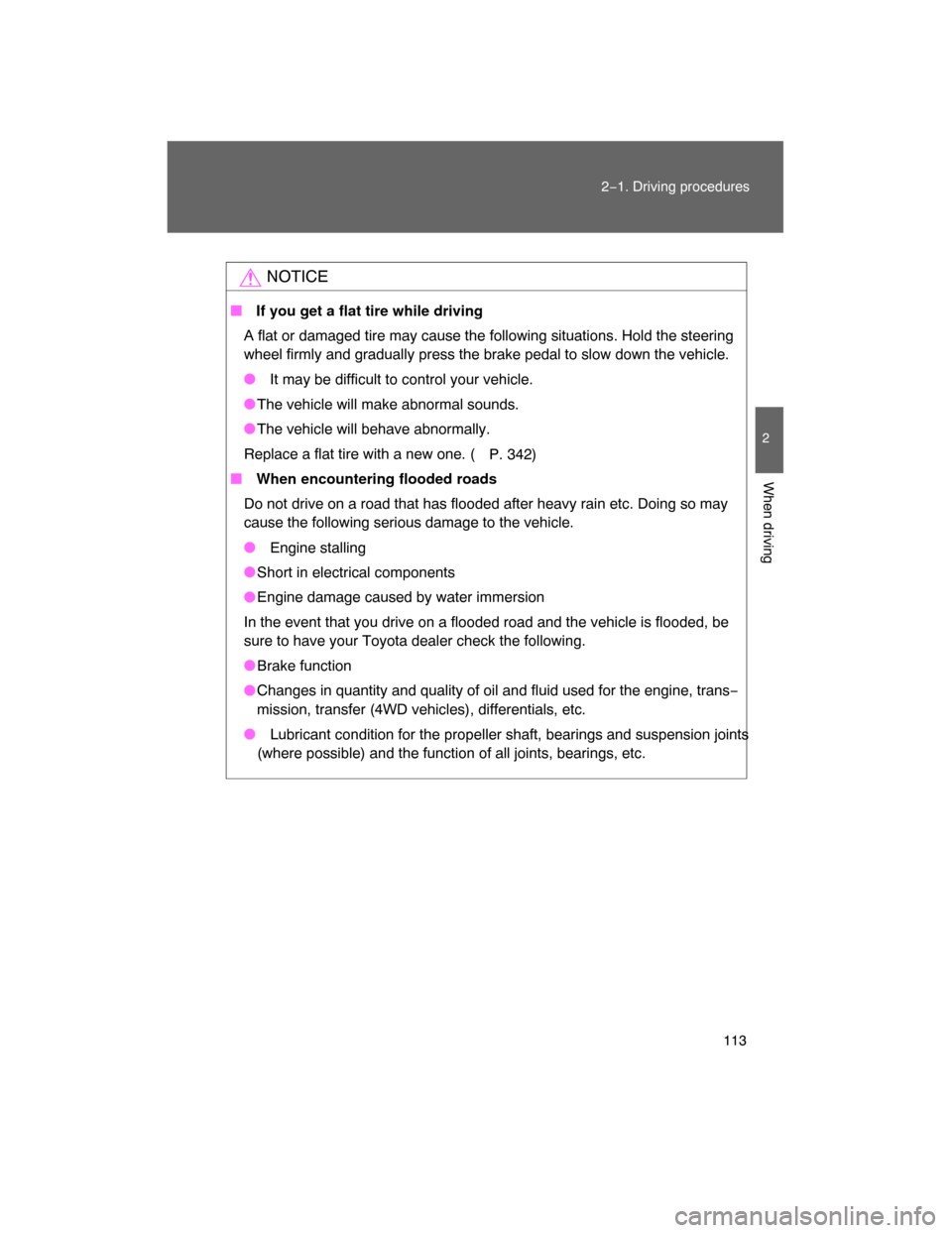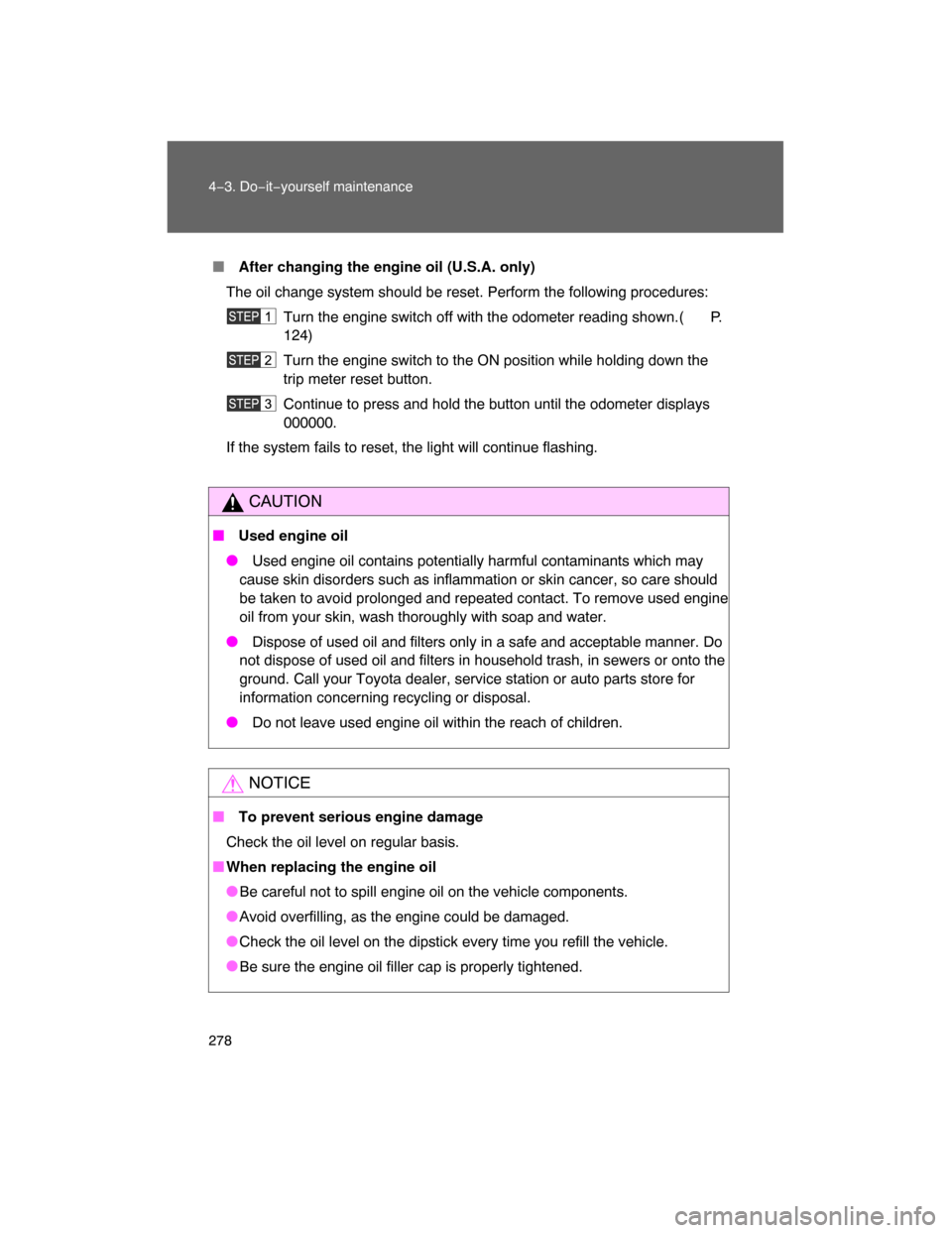Page 4 of 400

TABLE OF CONTENTSIndex
4
Floor mat ............................ 247
Luggage storage box (vehicles
without sub woofer) .......... 248
Luggage compartment
features ............................ 249
Compass ............................ 252
4�1. Maintenance and care ...... 258
Cleaning and protecting the
vehicle exterior ................. 258
Cleaning and protecting the
vehicle interior .................. 260
4�2. Maintenance ..................... 263
Maintenance
requirements .................... 263
General maintenance ......... 265
Emission inspection and
maintenance (I/M)
programs .......................... 268
4�3. Do�it�yourself
maintenance ................... 269
Do−it−yourself service
precautions ...................... 269
Hood ................................... 273
Engine compartment .......... 274
Tires ................................... 287
Tire inflation pressure ......... 292
Wheels ............................... 296
Air conditioning filter ........... 298
Key battery ......................... 301
Checking and replacing
fuses ................................ 303
Light bulbs .......................... 3145�1. Essential information ....... 322
If your vehicle needs to be
towed ................................ 322
If you think something is
wrong ................................ 327
Fuel pump shut off
system .............................. 328
Event data recorder ............ 329
5�2. Steps to take in an
emergency ...................... 331
If a warning light turns on
or a warning buzzer
sounds... ........................... 331
If you have a flat tire ........... 340
If the engine will not start .... 350
If the shift lever cannot be
shifted from P ................... 351
If you lose your keys ........... 352
If the vehicle battery is
discharged ........................ 353
If your vehicle overheats ..... 356
If the vehicle becomes
stuck ................................. 359
6�1. Specifications ................... 362
Maintenance data
(fuel, oil level, etc.) ........... 362
Fuel information .................. 372
Tire information ................... 375
4Maintenance and care
5When trouble arises
6Vehicle specifications
Page 111 of 400

113
2−1. Driving procedures
2
When driving
NOTICE
� If you get a flat tire while driving
A flat or damaged tire may cause the following situations. Hold the steering
wheel firmly and gradually press the brake pedal to slow down the vehicle.
� It may be difficult to control your vehicle.
�The vehicle will make abnormal sounds.
�The vehicle will behave abnormally.
Replace a flat tire with a new one. (
P. 342)
� When encountering flooded roads
Do not drive on a road that has flooded after heavy rain etc. Doing so may
cause the following serious damage to the vehicle.
� Engine stalling
�Short in electrical components
�Engine damage caused by water immersion
In the event that you drive on a flooded road and the vehicle is flooded, be
sure to have your Toyota dealer check the following.
�Brake function
�Changes in quantity and quality of oil and fluid used for the engine, trans−
mission, transfer (4WD vehicles), differentials, etc.
� Lubricant condition for the propeller shaft, bearings and suspension joints
(where possible) and the function of all joints, bearings, etc.
Page 162 of 400

164 2−5. Driving information
NOTICE
� To prevent the water damage
� Take all necessary safety measures to ensure that water damage to the
engine or other components does not occur.
Water entering the engine air intake will cause severe engine damage.
�Water entering the automatic transmission will cause deterioration in shift
quality, locking up of your transmission accompanied by vibration, and ulti−
mately damage.
� Water can wash the grease from wheel bearings, causing rusting and pre−
mature failure, and may also enter the differentials, transmission and
transfer case, reducing the gear oil’s lubricating qualities.
� When you drive through water
If driving through water, such as when crossing shallow streams, first check
the depth of the water and the bottom of the river bed for firmness. Drive
slowly and avoid deep water.
� Inspection after off�road driving
� Sand and mud that has accumulate
d in brake drums and around brake
discs may affect braking efficiency and may damage brake system compo−
nents.
� Always perform a maintenance inspection after each day of off−road driv−
ing that has taken you through rough terrain, sand, mud, or water. For
scheduled maintenance information, refer to the “Scheduled Maintenance
Guide” or “Owner ’s Manual Supplement”.
Page 167 of 400

169
2−5. Driving information
2
When driving
Winter driving tips
Carry out the necessary preparations and inspections before driving
the vehicle in winter. Always drive the vehicle in a manner appropri�
ate to the prevailing weather conditions.
� Pre�winter preparations
� Use fluids that are appropriate to the prevailing outside tem−
peratures.
�Engine oil
�Engine coolant
�Washer fluid
� Have a service technician inspect the level and specific grav−
ity of battery electrolyte.
�Have the vehicle fitted with four snow tires or purchase a set
of tire chains for the rear tires.
Ensure that all tires are the same size and brand, and that chains
match the size of the tires.
� Before driving the vehicle
Perform the following according to the driving conditions.
�
Do not try to forcibly open a window, scrape an outside rear
view mirror surface or move a wiper or outside rear view mir−
ror that is frozen. Pour warm water over the frozen area to
melt the ice. Wipe away the water immediately to prevent it
from freezing.
�To ensure proper operation of th e climate control system fan,
remove any snow that has accumulated on the air inlet vents
in front of the windshield.
�Remove any ice that has accumulated on the vehicle chassis.
�
Periodically check for and remo ve any excess ice or snow
that may have accumulated in the wheel well or on the
brakes.
Page 261 of 400
265
4−2. Maintenance
4
Maintenance and care
General maintenance
Engine compartment
Items Check points
Battery Maintenance−free. ( P. 283)
Brake fluid At the correct level? ( P. 280)
Engine coolant At the correct level? ( P. 279)
Engine oil At the correct level? ( P. 275)
Exhaust system No fumes or strange sounds?
Power steering fluid At the correct level? (
P. 282)
Radiator/condenser/hosesNot blocked with foreign matter?
(
P. 280)
Washer fluid At the correct level? (
P. 286)
Listed below are the general maintenance items that should be per�
formed at the intervals specified
in the “Scheduled Maintenance
Guide” or “Owner ’s Manual Supp lement”. It is recommended that
any problem you notice should be brought to the attention of your
Toyota dealer or qualifie
d service shop for advice.
Page 271 of 400
275
4−3. Do−it−yourself maintenance
4
Maintenance and care
Engine oil
With the engine at operating temperature and turned off, check the oil
level on the dipstick.
� Checking the engine oil
Park the vehicle on level gro und. After turning off the engine,
wait a few minutes for the oil
to drain back into the bottom of
the engine.
Hold a rag under the end and
pull the dipstick out.
Wipe the dipstick clean.
Reinsert the dipstick fully.
Holding a rag under the end, pull the dipstick out and check
the oil level.
Wipe the dipstick and reinsert it fully.
Low
Full
Page 272 of 400
276 4−3. Do−it−yourself maintenance
� Adding engine oil
If the oil level is below or near
the low level mark, add engine
oil of the same type as already in
the engine.
Make sure to check the oil type and prepare the items needed before
adding oil.
Remove the oil filler cap, turning it counterclockwise.
Add engine oil slowly.
Checking the dipstick.
Reinstall the filler cap, turning it clockwise.
The approximate quantity of oil needed to raise the level between low and
full on the dipstick is indicated as follows:
1.6 qt. (1.5 L, 1.3 lmp. qt.)
�
Recommended viscosity
SAE 5W−30 is the best choice for
good fuel economy, and good
starting in cold weather.
*: If SAE 5W−30 oil is not avail−
able, SAE 10W−30 oil may be
used. However, it should be
replaced with SAE 5W−30 at
the next oil change.
Oil grade ILSAC multigrade engine oil
Items Clean funnel
Outside temperature
Page 274 of 400

278 4−3. Do−it−yourself maintenance
� After changing the engine oil (U.S.A. only)
The oil change system should be reset. Perform the following procedures:
Turn the engine switch off with the odometer reading shown.( P.
124)
Turn the engine switch to the ON position while holding down the
trip meter reset button.
Continue to press and hold the button until the odometer displays
000000.
If the system fails to reset, the light will continue flashing.
CAUTION
� Used engine oil
� Used engine oil contains potentially harmful contaminants which may
cause skin disorders such as inflammation or skin cancer, so care should
be taken to avoid prolonged and repeated contact. To remove used engine
oil from your skin, wash thoroughly with soap and water.
� Dispose of used oil and filters only in a safe and acceptable manner. Do
not dispose of used oil and filters in household trash, in sewers or onto the
ground. Call your Toyota dealer, service station or auto parts store for
information concerning recycling or disposal.
� Do not leave used engine oil within the reach of children.
NOTICE
� To prevent serious engine damage
Check the oil level on regular basis.
�When replacing the engine oil
�Be careful not to spill engine oil on the vehicle components.
�Avoid overfilling, as the engine could be damaged.
�Check the oil level on the dipstick every time you refill the vehicle.
�
Be sure the engine oil filler cap is properly tightened.